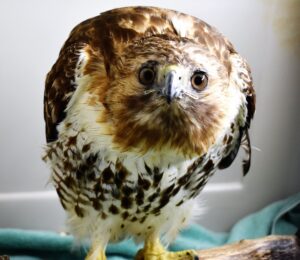EASTHAM — Sometimes, when a bird arrives at Wild Care, the wildlife rehabilitation center here, Executive Director Stephanie Ellis knows instantly what it is suffering from.

She recalls when a great horned owl was found slumped on the ground in Wellfleet in 2017. It was unresponsive, thin, anemic, and so weak it put up no fight when a human picked it up. She was learning that these symptoms pointed to only one cause: rat poison.
Here and around the country, hawks, eagles, foxes, coyotes, and other predators suffer from what is called “secondary” poisoning from rodenticides. A rat or mouse will eat poisoned bait, then a predator will eat the poisoned rodent. As the predator eats more rodents, the poisons accumulate in its body and eventually kill the animal.
While some of the predators brought to Wild Care with rodenticide poisoning survive, Ellis says she has watched dozens of raptors die from the poisons used by pest control companies and homeowners.
Efforts are underway to address the most frequently used class of rodent poisons — second-generation anticoagulant rodenticides, or SGARs — at the state level. At the same time, towns are asking for some authority to restrict their use. At their town meetings this spring, both Eastham and Wellfleet passed home-rule petitions that, if approved by the state legislature, will grant them permission to ban outdoor use of a variety of pesticides, including SGARs and other chemical rodenticides. Orleans passed a similar petition in the fall of 2023.
The bylaws proposed in the petitions would not prevent people from using SGARs indoors. Towns do, however, have the authority to ban the use of SGARs on town-owned property; Newbury and Lexington have already done this.
Of Rats and Raptors
When you call an exterminator to deal with a mouse or rat infestation, the company will likely use an SGAR. These poisons work by preventing rodents’ blood from clotting, which causes internal bleeding that eventually leads to death.

It can take a few days for rodents to die after eating SGARs, giving predators plenty of time to pick them off and get poisoned themselves. Additionally, poisoned rodents are weak and often dehydrated, which draws them into the open looking for water and makes them easy prey.
SGAR use is common. According to the Mass. Dept. of Agricultural Resources Pesticide Program, 96 percent of rodenticides applied by pest control companies in 2022 — that is, approximately 536,000 pounds — were SGARs.
The most prominent victims of secondary rodenticide poisoning are raptors like hawks, eagles, and owls. A study by the Tufts Wildlife Clinic found that of the 94 birds of prey admitted there between 2012 and 2016 96 percent tested positive for SGARs. A later study by the same clinic found SGAR poisoning in all 43 red-tailed hawks admitted between 2017 and 2019.
Ellis says that nearly every large raptor they get at Wild Care has rodenticide exposure. They even took in a broad-winged hawk chick that had been exposed to the poisons without ever leaving the nest — its parents had been unknowingly raising it on poisoned rodents. (The hawk survived.)
When a raptor is exposed to enough rodenticides to kill it, death is gruesome. The predator gets lethargic and disoriented. Its skin is bruised from internal bleeding. It might go blind. Blood starts pouring out of its feather shafts, its cloaca, and its mouth. “If people could see what a hawk looks like when it’s dying from rodenticides, I think they would really think twice about using these poisons,” Ellis says.
Mammals, too, suffer heavily from rodenticides. A study of fishers (or fisher cats as they are known colloquially) opportunistically trapped across Vermont and New Hampshire in 2018 and 2019 found that 98 percent had SGAR poisoning. Another study on 46 predators, including foxes and coyotes as well as birds of prey, that were admitted to Cape Ann Wildlife rehabilitation center from 2022 to 2024 found that all had SGAR poisoning.
Ellis says that, for predators, SGAR poisoning is endemic, even in rural areas like the Outer Cape. “You think it’s a city problem, and it’s not,” she says.
If Ellis or another qualified rehabilitation worker can get to them early, it is possible for poisoned raptors to survive. If a raptor is looking lethargic and a blood sample is unable to clot within eight minutes, she treats the raptor with fluids and vitamin K injections to stimulate red blood cell production. Sometimes, the bleeding stops and the raptors perk up and seem to be back to normal, Ellis says.
State-Level Legal Challenges
Each year, every pesticide that is available in Massachusetts needs to be re-registered by the state Pesticide Board Subcommittee, which determines whether it needs to be restricted or banned because of its effects on humans or the environment. The effects on the latter are the basis of a new petition prepared by the Harvard Law School Animal Law & Policy Clinic, which aims to suspend the registration of SGARs and other anticoagulant rodenticides.

The petition cites the section of the Mass. Pesticide Control Act that states that pesticides can be approved only if they “will not generally cause unreasonable adverse effects on the environment.” The petition argues that the secondary poisoning of predators constitutes unreasonable adverse environmental effects.
The petition also notes that at least four bald eagles, which are a protected species under both federal and state law, have died in Massachusetts due to SGAR poisoning. “From our perspective, we had doubts that the agency was seriously looking at the environmental impact of anticoagulant rodenticides,” says Rachel Mathews, an instructor at the policy clinic who co-authored the petition.
The petition was filed on behalf of a coalition of wildlife rehabilitation practitioners, though Ellis was not involved. The coalition also filed a separate request with the Executive Office of Energy and Environmental Affairs to study the effect of rodenticides on state endangered species.
The annual approval process will be completed by June 30. If Massachusetts outlaws these rodenticides, it will become the second state to do so; California implemented a law banning SGARs in 2021.
Ellis points out that whatever the law may allow, killing raptors is counterproductive if the goal is pest control. Raptors, she says, are the best pest control we have. “Everyone needs more hawks and owls,” she says.



